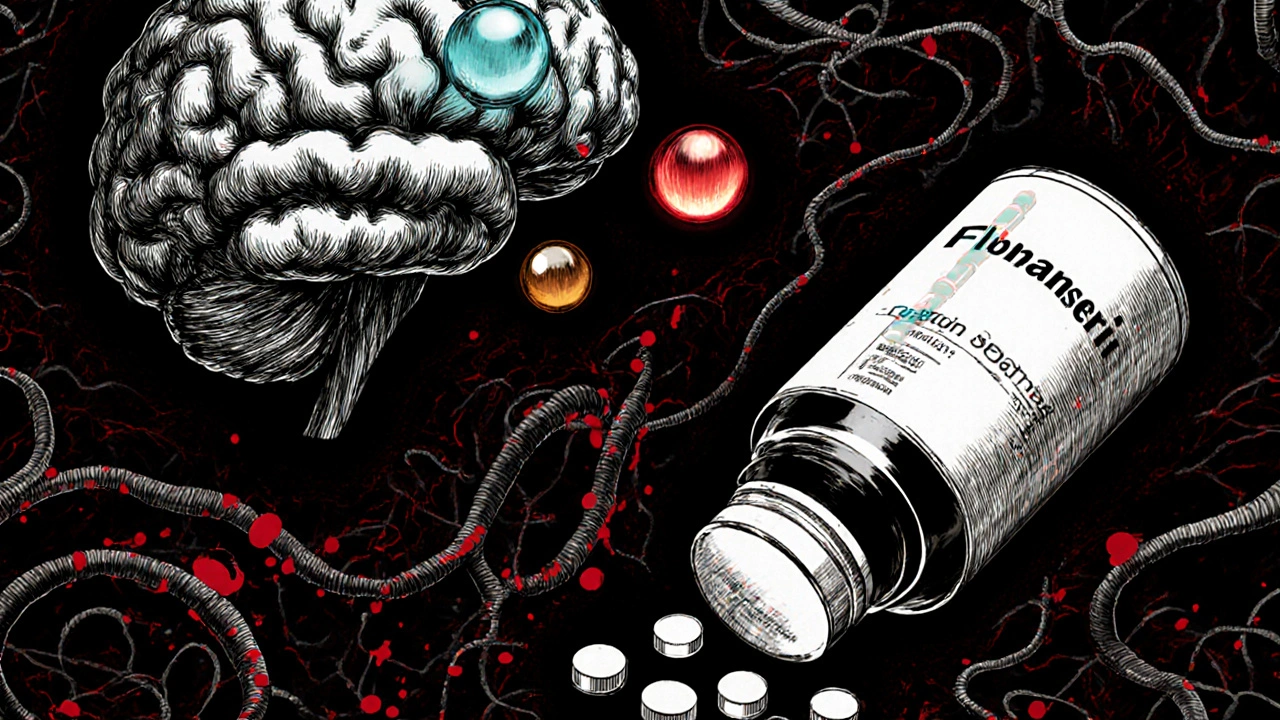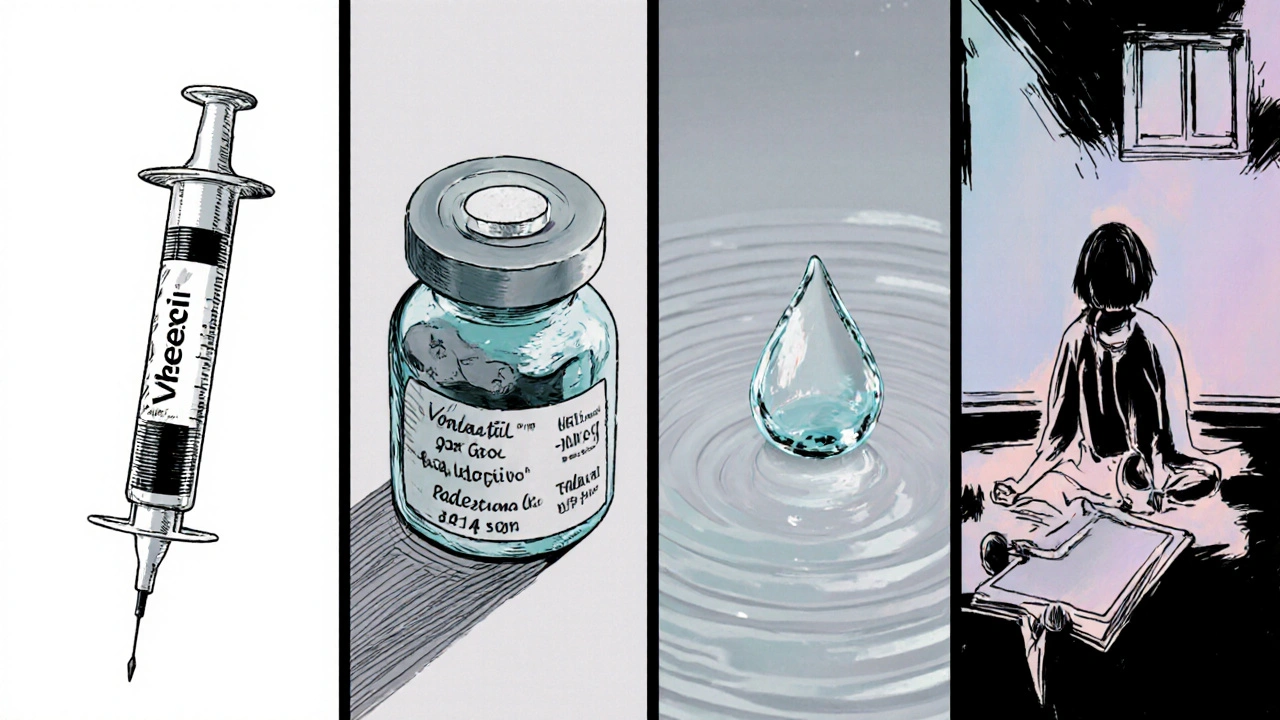
Low Sexual Desire Treatment Comparison Tool
Treatment Comparison
Select your preferences to see which treatment options might work best for you based on the factors discussed in the article.
Recommended Treatment Options
Low sexual desire can feel isolating, especially when you’ve tried over‑the‑counter fixes with no luck. In the last decade the FDA approved a handful of prescription options, the most famous being Flibanserin a serotonin‑modulating pill marketed for pre‑menopausal women with hypoactive sexual desire disorder (HSDD). But Flibanserin isn’t a one‑size‑fits‑all solution - it has strict dosing rules, side‑effects, and a price tag that can surprise many. That’s why a growing number of women and clinicians are looking at other routes, from on‑demand injections to simple lifestyle tweaks.
What Is Flibanserin?
Flibanserin (brand name Addyi) was the first oral drug specifically approved for HSDD in women. The pill comes in 100 mg tablets taken once daily at bedtime. FDA approval in 2015 was based on two 24‑week trials that showed a modest increase (about 0.5-1 point on the Female Sexual Function Index) compared with placebo.
Key facts:
- Indicated for pre‑menopausal women who report persistent low sexual desire for at least six months.
- Must be taken with a full night’s sleep; alcohol can cause dangerous drops in blood pressure.
- Typical side‑effects: dizziness, nausea, fatigue, and occasional hypotension.
How Does Flibanserin Work?
Unlike Viagra, which boosts blood flow, Flibanserin targets neurotransmitters. It’s a mixed agonist‑antagonist that:
- Acts as a serotonin 5‑HT1A receptor agonist - this can lift mood and reduce inhibition.
- Blocks serotonin 5‑HT2A receptors - lowering serotonin’s dampening effect on desire.
- Increases dopamine and norepinephrine levels in the prefrontal cortex - both are linked to increased libido.
The net result is a subtle shift in brain chemistry that may make sexual thoughts feel more natural. Because the brain’s chemistry is involved, the drug needs weeks to show benefit, and consistent nightly dosing is crucial.
Key Concerns & Side Effects
Any medication that touches serotonin can interfere with other drugs. The biggest red flag is the interaction with moderate or heavy alcohol intake - the combo can cause severe hypotension and fainting. Doctors usually advise a strict "no‑drink" rule while on Flibanserin.
Other common side‑effects include:
- Dizziness (up to 30% of users)
- Nausea (about 15%)
- Sleepiness or fatigue (10-12%)
- Dry mouth and headache (lower incidence)
Because the pill is taken at bedtime, some women find the drowsiness actually helpful. Others, however, report that the daytime fog lingers, affecting work performance. Cost is another practical barrier - most insurers cover the drug only after a documented trial of lifestyle changes and counseling.

Top Alternatives to Flibanserin
If Flibanserin doesn’t fit your lifestyle, health profile, or budget, several other options exist. Below is a quick rundown of the most talked‑about alternatives.
Bremelanotide Vyleesi - On‑Demand Injection
Bremelanotide is a melanocortin‑4 receptor agonist delivered as a 1 mg sub‑cutaneous injection about 45 minutes before sexual activity. It’s approved for both pre‑ and post‑menopausal women with HSDD.
- Pros: Fast onset (within an hour), no nightly dosing, works for occasional activity.
- Cons: Injection can be a turn‑off for some, side‑effects include nausea, flushing, and temporary increase in blood pressure.
- Typical cost: $250‑$300 per two‑dose pack, sometimes covered with prior authorization.
Tadalafil - Off‑Label for Women
Best known as Cialis for erectile dysfunction, Tadalafil is sometimes prescribed off‑label to improve genital blood flow in women. The dose is usually 5 mg daily.
- Pros: Daily oral pill, improves blood flow, generally well‑tolerated.
- Cons: Not FDA‑approved for HSDD, limited data on efficacy for women, possible headache, back pain, and rare visual disturbances.
- Cost: Often cheaper than Flibanserin because it’s generic.
Testosterone Therapy - Hormonal Approach
Low‑dose testosterone pellets, patches, or gels can boost libido in women with documented low testosterone levels. The therapy is usually monitored with blood tests every 2‑3 months.
- Pros: Can improve desire, energy, and mood; effects may appear within weeks.
- Cons: Risks include acne, hirsutism, lipid changes, and rare cardiovascular concerns.
- Cost: Varies widely; insurance may cover if a hormone deficiency is proven.
Lifestyle & Psychotherapy - Non‑Pharmacologic
Often the first line of treatment, lifestyle changes address stress, relationship dynamics, and overall health.
- Exercise (30 min most days) raises endorphins and improves body image.
- Mindfulness‑based sex therapy helps couples communicate desire and reduce performance anxiety.
- Addressing sleep, nutrition, and alcohol use can have a surprisingly large impact on libido.
While not a “pill,” many women report comparable or greater benefit than medication after a few months of consistent practice.
Emerging Options - Oxytocin Nasal Spray & Lofexidine
Research is still early, but intranasal oxytocin shows promise for boosting emotional closeness and desire. Lofexidine, a clonidine analogue, is being studied for its ability to modulate norepinephrine pathways. Both are not yet FDA‑approved for HSDD but may become alternatives in the next few years.
Comparison Table: Flibanserin vs Main Alternatives
| Attribute | Flibanserin (Addyi) | Bremelanotide (Vyleesi) | Tadalafil (off‑label) | Testosterone | Lifestyle & Psychotherapy |
|---|---|---|---|---|---|
| Formulation | Oral tablet, 100 mg nightly | Sub‑cutaneous injection, 1 mg PRN | Oral tablet, 5 mg daily | Gel/patch/pellet, low dose | Exercise, counseling, sleep hygiene |
| Onset of effect | 4-6 weeks | 45-60 minutes | 1-2 weeks | 2-4 weeks | 4-8 weeks (depends on adherence) |
| Typical efficacy increase (FSFI points) | ~0.5-1.0 | ~0.7-1.2 | ~0.3-0.6 (limited data) | ~0.8-1.4 (when low T confirmed) | ~0.5-1.0 (varies widely) |
| Common side‑effects | Dizziness, nausea, fatigue, hypotension with alcohol | Nausea, flushing, transient BP rise | Headache, back pain, indigestion | Acne, hirsutism, lipid changes | Time commitment, occasional frustration |
| Insurance coverage (US) | Partial, prior‑auth often required | Partial, prior‑auth often required | Usually covered as generic | Covered if hormonal deficiency proven | Usually out‑of‑pocket (counseling rates vary) |
| Cost (average per month) | $150‑$200 | $125‑$150 (per two doses) | $30‑$60 (generic) | $50‑$250 (depends on formulation) | $0‑$300 (depends on therapist) |

Choosing the Right Option: Decision Factors
When you sit down with your provider, ask yourself these five questions. The answers will narrow the field quickly.
- How often do you need the medication? If you’re looking for an “as‑needed” boost, Bremelanotide’s PRN injection may win. For daily consistency, Flibanserin or Tadalafil make sense.
- Are you comfortable with injections? Some women hate needles; others find the short‑term commitment easier than a nightly pill.
- Do you drink alcohol regularly? Flibanserin’s strict no‑alcohol rule can be a deal‑breaker for social drinkers.
- What’s your budget and insurance status? Generic Tadalafil and lifestyle coaching often cost less than brand‑name pills.
- Are there underlying hormonal issues? A simple blood test can reveal low testosterone, making hormone therapy a logical first step.
Most clinicians recommend trying a non‑pharmacologic approach for three months before prescribing medication. If desire doesn’t improve, they’ll move to the next tier based on your answers above.
Frequently Asked Questions
Can I take Flibanserin and birth control pills together?
Yes. Flibanserin does not interfere with hormonal contraceptives. In fact, most studies required participants to be on a reliable birth control method.
How long does Bremelanotide stay active after injection?
The drug’s half‑life is about 2.7 hours, with most women feeling the effect for 2-4 hours after the dose.
Is testosterone therapy safe for women over 50?
When dosed low and monitored, it can be safe. However, older women should have cardiovascular screening and regular lipid panels.
Do lifestyle changes work as well as medication?
For many, a combination of regular exercise, stress reduction, and couple’s counseling yields improvements comparable to a modest medication response. The key is consistency.
What should I do if I experience dizziness on Flibanserin?
Contact your prescriber right away. They may lower the dose, adjust timing, or suggest an alternative if dizziness persists.
Bottom line: there’s no single “best” drug for every woman with low desire. Flibanserin offers a daily oral option, but alternatives like Bremelanotide, low‑dose Tadalafil, testosterone, and even focused lifestyle work can be more suitable depending on your routine, health profile, and personal comfort. Talk openly with a qualified clinician, compare the pros and cons in the table above, and choose the path that aligns with your life.

I think many women appreciate the thorough breakdown of each option. The table really helps compare side‑effects and costs at a glance. It's good to see lifestyle changes listed alongside pharmaceuticals. Understanding the trade‑offs can make the decision feel less overwhelming.
Great summary and it’s clear which therapies suit different lifestyles. The on‑demand injection stands out for occasional use. Keeping it concise helps readers digest the info quickly.
Let’s be real – you can’t ignore the moral cost of med‑selling. Pills promise quick fixes while ignoring deeper issues. The drama of a nightly pill is just a marketing ploy. People need to question who profits. Truth matters above all.
I hear the frustration many feel when a medication doesn’t match expectations. It helps to pair any drug with counseling; the mind and body are linked. Patience is crucial because benefits often take weeks. Keep an open dialogue with your provider. Supportive care can make the difference.
Consider the insurance implications before committing.
When we examine the landscape of treatments for hypoactive sexual desire disorder, we must first acknowledge the societal pressures that drive women toward pharmacological solutions. The pharmaceutical industry has, for decades, capitalized on the narrative that desire is a problem to be fixed, not a complex interplay of biology, psychology, and relational dynamics. Flibanserin, marketed under the brand Addyi, epitomizes this trend: a daily pill that promises modest gains in libido while imposing stringent restrictions, such as the absolute prohibition of alcohol, which is unreasonable for many adult lives. Its modest efficacy-an increase of merely half a point on the FSFI-raises the question of whether the trade‑off of dizziness, nausea, and potential hypotension is worth it. On the other hand, Bremelanotide offers a different model: a powerful, on‑demand injection that sidesteps the nightly regimen, yet introduces the discomfort of self‑administration and the side‑effects of flushing and a temporary blood pressure rise. Tadalafil, a generic medication commonly used for erectile dysfunction, provides an off‑label, low‑cost alternative with a safety profile better understood, but its off‑label nature leaves patients navigating murky insurance waters. Testosterone therapy, often hailed as a “natural” hormone replacement, can indeed restore desire in women with documented deficiencies, yet the risk of virilization, lipid disturbances, and cardiovascular concerns cannot be dismissed lightly. Lifestyle modifications, while seemingly simplistic, are backed by robust data: regular exercise raises endorphins, mindfulness therapy reduces anxiety, and improved sleep hygiene restores hormonal balance-all without the risk of pharmacologic side‑effects. Moreover, the emerging research on intranasal oxytocin and lofexidine points to a future where neuromodulation could target desire more precisely, though these are still in experimental phases. The decision matrix for any patient must weigh not only efficacy and side‑effects but also personal values, daily routines, and financial realities. Insurance coverage remains a major hurdle; generic Tadalafil often sails through, whereas brand‑named Flibanserin and Vyleesi encounter prior‑authorization roadblocks, inflating out‑of‑pocket costs. Clinicians should adopt a stepwise approach: begin with non‑pharmacologic strategies, assess hormonal panels, and then consider medication based on individual risk‑benefit analyses. Finally, the conversation about sexual desire should be destigmatized, encouraging open dialogue between partners and providers, because no single pill can replace the nuanced intimacy that thrives on communication, trust, and mutual respect.
That was an excellent deep dive. I especially appreciated the point about starting with lifestyle changes. It’s easy to overlook how much simple habits can shift chemistry. Thanks for the balanced perspective.
Statistically, the efficacy data you presented aligns with meta‑analyses showing modest FSFI improvements across all pharmacologic options. However, the cost‑effectiveness ratio heavily favors generic Tadalafil when considering QALYs. 📊
One must question the underlying motivations of the pharmaceutical conglomerates that champion these “solutions.” The veneer of scientific rigor often masks a profit‑driven agenda that pathologizes normal variations in desire. Moreover, the selective publication of favorable trials creates an illusion of efficacy that does not survive rigorous scrutiny. While the table is aesthetically pleasing, it glosses over the epistemic uncertainty that pervades this field. In an age where data is weaponized, consumers deserve transparency beyond glossy pamphlets.
Whoa, big talk! All that fancy wording makes it sound like a conspiracy. I just want something that works without waving a flag. Let’s keep it real.
From a pharmacodynamic standpoint, the serotonergic mechanism of Flibanserin differs fundamentally from the vasodilatory action of Tadalafil. The former modulates central pathways, influencing mood and inhibition, while the latter enhances peripheral blood flow. Clinical trials suggest that the central approach yields variable outcomes, potentially due to individual neurochemical baselines. Conversely, the peripheral approach benefits from more predictable hemodynamic responses. Therefore, patient selection should be guided by comprehensive neuroendocrine assessment.
Interesting data, but I’d argue the cultural narrative pushes medication over personal agency.